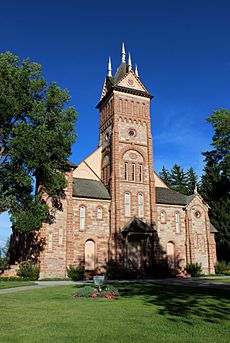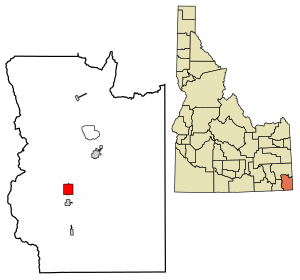Paris, Idaho facts for kids
Quick facts for kids
Paris, Idaho
|
|
|---|---|

Stone Tabernacle (Bear Lake Stake Tabernacle), c. 1889
|
|

Location of Paris in Bear Lake County, Idaho.
|
|
| Country | United States |
| State | Idaho |
| County | Bear Lake |
| Area | |
| • Total | 3.52 sq mi (9.11 km2) |
| • Land | 3.49 sq mi (9.03 km2) |
| • Water | 0.03 sq mi (0.07 km2) |
| Elevation | 5,975 ft (1,821 m) |
| Population
(2020)
|
|
| • Total | 541 |
| • Density | 149.37/sq mi (57.68/km2) |
| Time zone | UTC-7 (Mountain (MST)) |
| • Summer (DST) | UTC-6 (MDT) |
| ZIP codes |
83261, 83287
|
| Area code(s) | 208, 986 |
| FIPS code | 16-60580 |
| GNIS feature ID | 2411370 |
Paris is a small city in Idaho, United States. It is the main town for Bear Lake County. The city is located on the western side of the Bear Lake Valley.
In 2020, about 541 people lived in Paris. The city was first settled on September 26, 1863. It was founded by early settlers from the Church of Jesus Christ of Latter-day Saints.
These settlers were led by Charles C Rich. In the beginning, the pioneers faced many challenges. The cold climate was especially difficult.
Paris is also home to the Bear Lake Stake Tabernacle. This is a large church building made of sandstone. It was designed by Joseph Don Carlos Young and built between 1884 and 1889. The building can hold around 1,400 people.
Contents
History of Paris
Paris was started by Mormon pioneers. They began settling the area on September 29, 1863. This was done under the guidance of Charles C. Rich.
For many years, the settlers thought their town was in Utah. However, a survey in 1872 showed something different. It proved that Paris was actually located in Idaho.
Geography and Climate
Paris is a small city, covering about 3.51 square miles (9.09 km2) of land. Only a very small part, 0.03 square miles (0.08 km2), is water.
The city is located in a high valley within the Rocky Mountains. It sits at an elevation of nearly 6,000 feet (1,830 m) above sea level.
Weather in Paris
Paris has a climate known as a warm-summer humid continental climate. This means it has cold winters and mild summers. Spring also arrives late in the year.
Because Paris is so high up, the weather is often cold. Much of the land around Paris is used for ranching.
Population Information
The number of people living in Paris has changed over time. Here is how the population has grown and shrunk:
| Historical population | |||
|---|---|---|---|
| Census | Pop. | %± | |
| 1880 | 611 | — | |
| 1890 | 893 | 46.2% | |
| 1900 | 906 | 1.5% | |
| 1910 | 1,038 | 14.6% | |
| 1930 | 825 | — | |
| 1940 | 932 | 13.0% | |
| 1950 | 774 | −17.0% | |
| 1960 | 746 | −3.6% | |
| 1970 | 615 | −17.6% | |
| 1980 | 707 | 15.0% | |
| 1990 | 581 | −17.8% | |
| 2000 | 576 | −0.9% | |
| 2010 | 513 | −10.9% | |
| 2020 | 541 | 5.5% | |
| U.S. Decennial Census | |||
What the 2010 Census Showed
In 2010, there were 513 people living in Paris. These people lived in 202 homes. About 144 of these were families.
Most people in Paris were White (97.9%). A small number were African American (0.4%) or Asian (0.2%). Some people were from other backgrounds. About 2.3% of the population was Hispanic or Latino.
The average age of people in Paris was 40.2 years old. About 27.1% of residents were under 18. About 16.6% were 65 years old or older. Slightly more males (51.5%) lived in the city than females (48.5%).
Fun Events and Culture
The Paris July 4 Celebration is a very important event each year. Many people come from far away to join in.
The day starts with a fun run from Montpelier to Paris. After the run, the City of Paris holds a chuck wagon breakfast. The Bear Lake Pageant takes place at the Paris Tabernacle. This is followed by a parade through the city. The celebration ends with a rodeo for young people at the Paris rodeo grounds.
Ancient Life (Paleontology)
West of Paris, there are rocks that hold fossils. These fossils are remains of different ancient organisms.
A special place called Paris Canyon is known for its fossils. In 2017, scientists described many different ancient animals found there. They named this collection the Paris biota.
Transportation
 - U.S. Route 89 is a main road. It connects Paris to Montpelier (to the northeast) and Logan, Utah (to the southwest).
- U.S. Route 89 is a main road. It connects Paris to Montpelier (to the northeast) and Logan, Utah (to the southwest).
Famous People From Paris
- Arthur Shepherd (1880–1958), a well-known composer.
Images for kids
See also
 In Spanish: Paris (Idaho) para niños
In Spanish: Paris (Idaho) para niños



